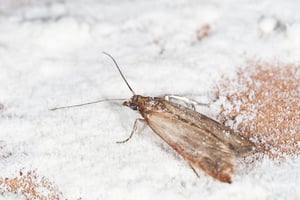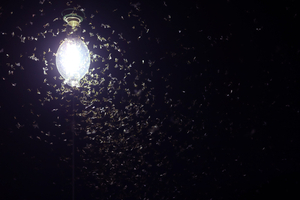All pest infestations are unpleasant, but pest infestations in your food are a special kind of upsetting. Unfortunately, they’re also all too common. Pantry moths are quite prevalent, and they infest thousands and thousands of households every year. A lot of people notice these infestations right around this time of year. In other words, you can’t assume you’re safe from pantry moth infestations. They could happen to anyone, and chances are they’ll happen in summer time. This is everything you need to know to make sure that doesn’t happen. By learning what pantry moths are and where they come from, you can keep your food safe.
What are pantry moths?
 Pantry moths are moths that feed on stored food. These moths primarily infest dry goods like grains, pasta, flour, cereals, and spices. Contrary to popular belief, adult pantry moths don’t actually eat stored food. Instead, they lay eggs onto it. When these eggs hatch, larvae eat the stored food.
The most common pantry moth is the Indian meal moth (Plodia interpunctella). Indian meal moth larvae chew through many containers. Adult Indian meal moths have wingspans of about ½ to ⅝”. They’re reddish-brown, with a distinctive tan spot on their front wings. Larvae are pale white, yellow, or brownish, with several small body segments. They resemble small worms.
Pantry moths are moths that feed on stored food. These moths primarily infest dry goods like grains, pasta, flour, cereals, and spices. Contrary to popular belief, adult pantry moths don’t actually eat stored food. Instead, they lay eggs onto it. When these eggs hatch, larvae eat the stored food.
The most common pantry moth is the Indian meal moth (Plodia interpunctella). Indian meal moth larvae chew through many containers. Adult Indian meal moths have wingspans of about ½ to ⅝”. They’re reddish-brown, with a distinctive tan spot on their front wings. Larvae are pale white, yellow, or brownish, with several small body segments. They resemble small worms.
What pantry moths want
 Adult pantry moths want to find food sources where they can lay their eggs. Ideally, these food sources will be in dark, sheltered areas where the moth and larvae can remain safe. The food itself should be accessible and plentiful, so the larvae can keep eating continuously. It should also be at least semi-soluble, so larvae can eat through it easily.
Obviously, most pantries check all of these boxes perfectly. Moths can also infest cabinets, drawers, and any other dry areas where you keep food. Commonly infested foods include cereal, grains, pasta, flour, cornmeal, oatmeal, seeds, nuts, corn, dried fruits, chocolate, and more.
Adult pantry moths want to find food sources where they can lay their eggs. Ideally, these food sources will be in dark, sheltered areas where the moth and larvae can remain safe. The food itself should be accessible and plentiful, so the larvae can keep eating continuously. It should also be at least semi-soluble, so larvae can eat through it easily.
Obviously, most pantries check all of these boxes perfectly. Moths can also infest cabinets, drawers, and any other dry areas where you keep food. Commonly infested foods include cereal, grains, pasta, flour, cornmeal, oatmeal, seeds, nuts, corn, dried fruits, chocolate, and more.
Why pantry moths are active in summer
Most pantry moths can remain active all year as long as they stay warm enough. The Indian meal moth can survive and reproduce as long as temperatures in its infested area stay above 50℉. Summer does afford moths the opportunity to become more mobile, however. When the outdoor temperature is cold, pantry moths tend to stay in the safety of their infested areas. When it’s warm enough for them to survive elsewhere, however, pantry moths tend to move around more. Many moth infestations begin in summer, when moths use the opportunity warmth provides to seek mates and food sources. How pantry moths get into your home
Pantry moths are attracted to light. They end up near your home when they fly toward light coming from your windows or doors. Once there, moths often find their way inside your home through gaps in frames or screens. They can also enter through gaps near vents and exhaust pipes or other utility lines. Moths and larvae frequently enter damaged containers to infest the food within. They could even sneak into containers while the food is in a store. Once moths have established an infestation, larvae spread out to other nearby food sources. Any food that’s not kept in a sealed container is especially prone to infestation. How to treat pantry moths
 Remove all food from your pantry, cabinet, or drawer and lay it out in the open. Throw out anything that’s infested and move everything else into sealed plastic containers. If you can, throw away all the food you stored in the infested area. Better safe than sorry.
After you’ve removed all the infested food, turn your attention to the infested area itself. Thoroughly clean the area with soap and hot water. Moth larvae will live pretty much anywhere inside infested places. They’re especially prone to building cocoons in secluded, hidden areas. Use a flashlight to double-check that you’ve cleaned everything after you’re done.
Remove all food from your pantry, cabinet, or drawer and lay it out in the open. Throw out anything that’s infested and move everything else into sealed plastic containers. If you can, throw away all the food you stored in the infested area. Better safe than sorry.
After you’ve removed all the infested food, turn your attention to the infested area itself. Thoroughly clean the area with soap and hot water. Moth larvae will live pretty much anywhere inside infested places. They’re especially prone to building cocoons in secluded, hidden areas. Use a flashlight to double-check that you’ve cleaned everything after you’re done.






